Invasive plants can spell trouble for local ecosystems, and they can rapidly outcompete native plants, reduce biodiversity and even threaten native wildlife. But while there are lots of different invasive plant species to be aware of, one particularly difficult type of invasive is the multiflora rose. Since they were first introduced as ornamental plants, multiflora roses have spread vigorously in the wild, and their fast growth rate and ability to reproduce quickly have made them particularly troublesome plants to deal with.
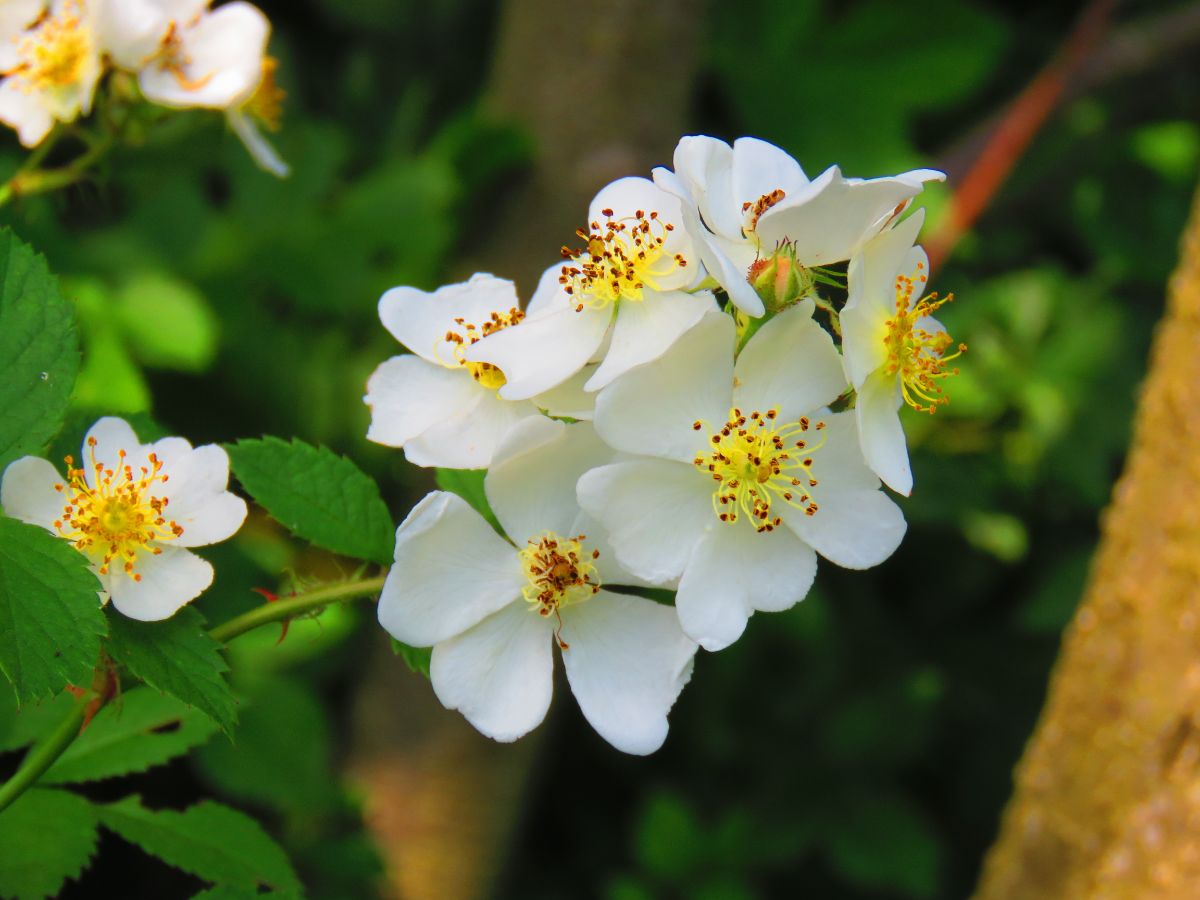
If you have a property with multiflora roses, it’s a good idea to remove these plants to keep them from spreading throughout your yard and onto neighboring properties. But most treatments involve chemical herbicides, which you may not want to use… especially if you keep an organic garden! The good news is that there are some effective all-natural ways to remove multiflora roses without chemicals, and you can discover those methods right in this guide.
Jump to:
Identifying multiflora rose

Before you begin removing multiflora roses, it’s important that you identify the plant correctly. However, because the multiflora rose can look similar to other rose types, it can be tricky at first to determine which type of rose is growing on your property. But there are a few key details that will make identifying this invasive easier.
The multiflora rose is typically found growing in wide open habitats, such as old pasture land and at the edges of forests and roadways. This fast-growing shrub can grow up to 15’ tall, but most plants stay around 6 to 8’ tall. Thorny branches have a long, arching growth habit, and they have the ability to root wherever they touch the soil, which is part of what makes this invasive plant so difficult to deal with.
The best time to identify multiflora rose is in May through June, as this is when the plant is in bloom. The easiest way to identify multiflora rose is by its flowers, which form in large clusters. Individual flowers each have 5 white petals, but otherwise, they look quite similar to other wild-type roses.
Beyond its flowers, multiflora rose has small, 1 to 1 ½” long oval leaves that have toothed margins. At the base of the leaf stem, these plants also have a distinct, fringed leaf structure that looks a bit like a fuzzy centipede. This section of the leaf is called a “stipule,” and it can help you positively ID this invasive plant.
When multiflora roses begin to fade, they produce an abundance of red rosehips that are about the size of a pea. These rosehips contain a lot of seeds and generally appear around August, and they can last on the shrub throughout the winter. For removal purposes, it’s essential to tackle multiflora rose invasions early in the season because if they are allowed to produce rosehips, they can scatter lots of seeds!
In most areas, the closest lookalike to multiflora roses are swamp roses, but swamp roses have pink-toned flowers. These roses also lack the stipule structure that is present on multiflora roses, and they have larger rosehips that have a hairy exterior.
How to get rid of multiflora rose
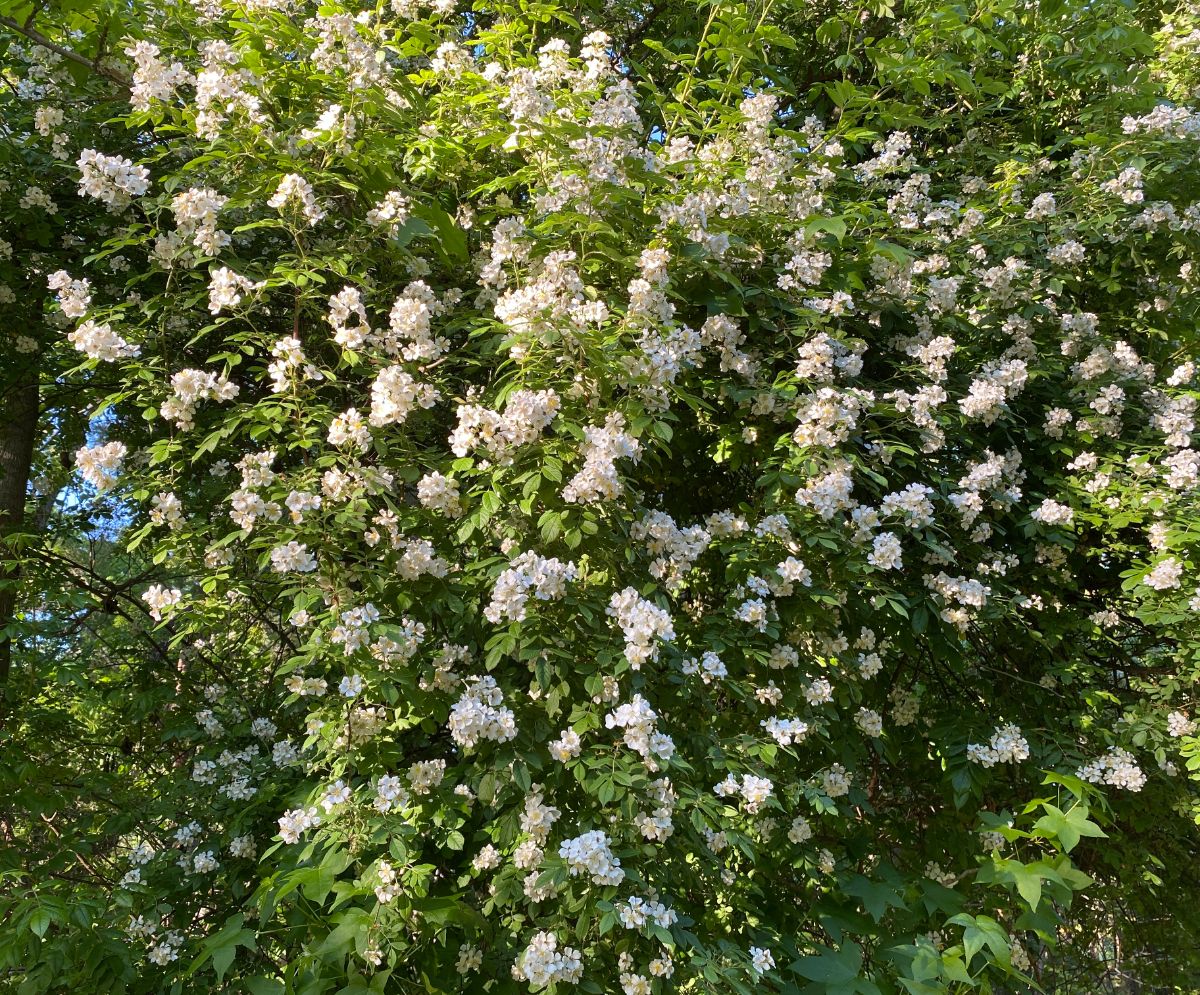
Invasive plants are tricky to remove, and multiflora rose is no exception. While chemical methods are commonly used to keep these plants in check, they’re not an option if you keep an organic garden. Plus, chemical herbicides can pose threats to waterways, wildlife, and more, so it’s best to avoid them whenever possible.
Removing multiflora rose through organic and all-natural means is doable, but the tradeoff is that you will need to be very consistent. Multiflora roses will generally need to be cut back several times in a growing season to make sure they don’t return, and large root systems may also need to be dug again if you didn’t remove the entire root ball at once. But removing invasives with organic means can be very effective, and it doesn’t have the potential to cause runoff and other related issues that can result from chemical herbicides.
No matter what method you use to tackle multiflora rose invasions, the best time to remove invasives is as soon as you possibly can. Multiflora rose can spread quickly, and it can produce a lot of seeds if it is allowed to flower. For this reason, aim to begin removing rose bushes in the spring or at least well before August, which is when these plants tend to set fruit and produce seeds.
Mowing and cutting
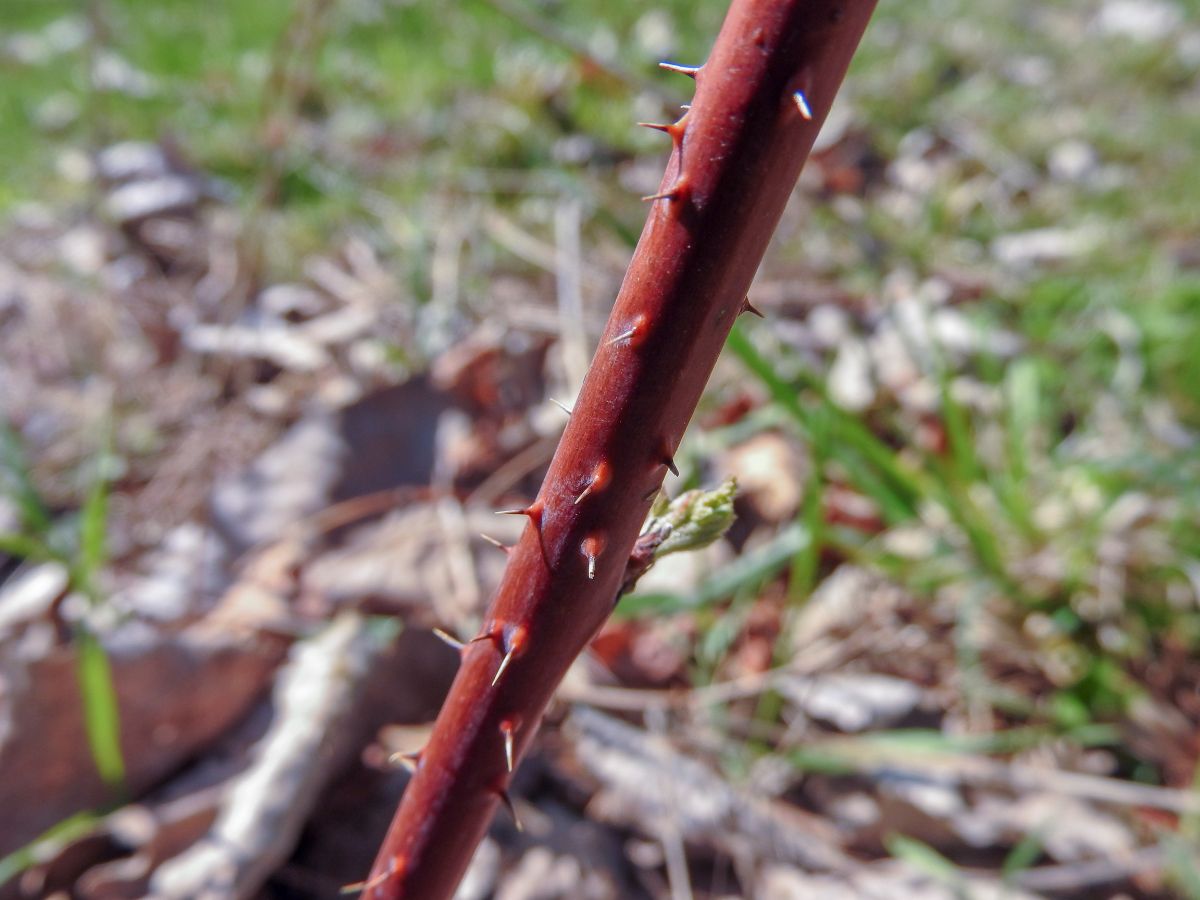
The first step to getting rid of multiflora rose is to remove as much of the above-ground plant material as possible, which will allow you to have better access to the plant’s root system. If you have a smaller patch of multiflora rose, you may be able to cut it down with a lawnmower or riding mower; however, larger rose bushes should be tackled with pruners and loppers. Cut as many stems as you can as low to the ground as possible and gather the material on a plastic tarp so you can properly dispose of it later.
Mowing and cutting multiflora roses can get rid of a lot of plant material fast, but to be effective, this process will need to be repeated several times. For best results, aim to mow or cut down rose bushes at least 3 to 6 times during a single growing season, and you may need to repeat this process the following year if you have a very large patch of multiflora rose. Begin removing plant material as early as you can in the season (either in late winter or early spring) and then continue cutting back the shrubs on a regular basis, especially if you see new growth begin to appear.
The goal of mowing and cutting multiflora rose is twofold. First, you want to remove as much of the plant as possible to limit the spread and to make the roots accessible. Secondly, repeatedly cutting back invasive plants deprives them of a lot of energy and nutrients and will eventually weaken and kill them over time.
While manual removal of multiflora roses can take some effort, it is an effective and chemical-free way to clean up your garden and remove this pesky invasive. Just remember to always wear eye protection when cutting back these plants, as their long branches often snap back and can cause injury. It’s also a good idea to opt for leather gardening gloves, which provide the best protection against rose thorns.
Digging and pulling
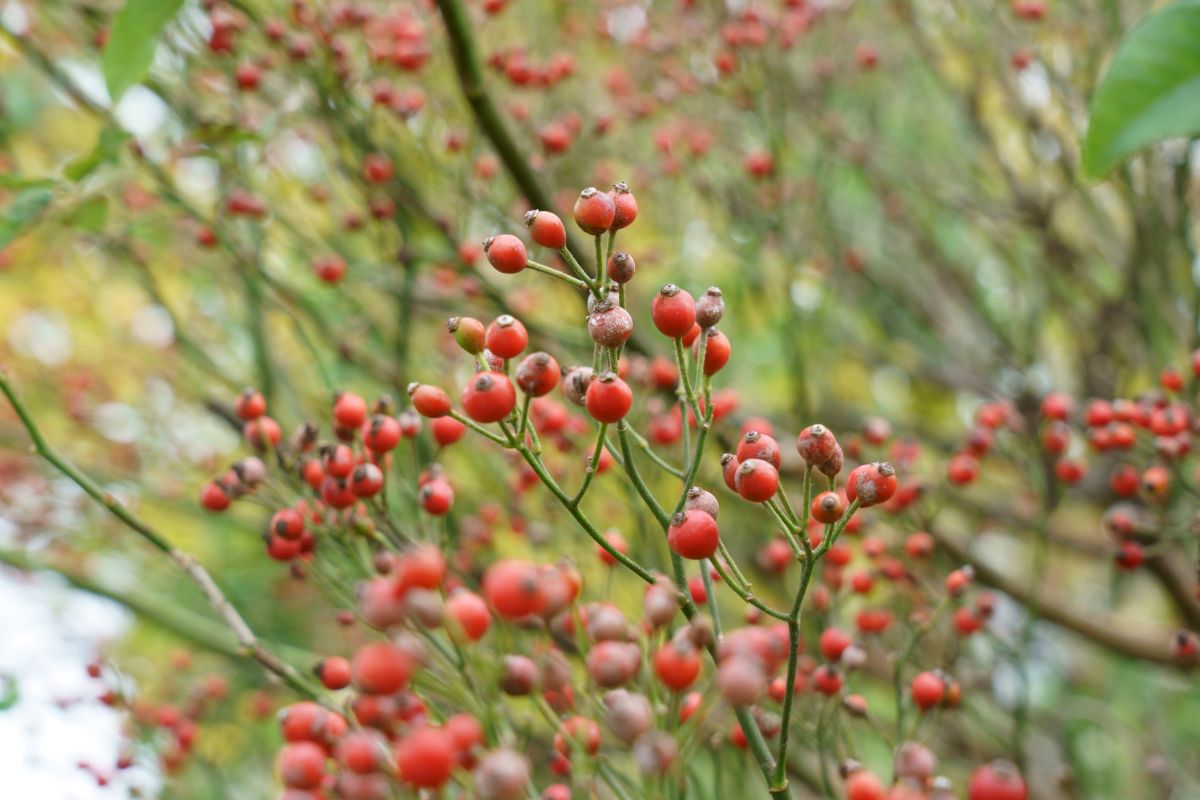
After cutting as many stems of the rosebush as low to the ground as you can, you’ll want to dig up the plant’s root ball. In some areas, this may be quite difficult, particularly if there are a lot of tree roots; however, weed wrenches can sometimes work in these tough spots, and they pull up plants, like multiflora roses, right from the roots.
The goal of digging and pulling is to remove as much of the rose’s root system as possible since plants can resprout from a small bit of root. Ideally, you’ll want to remove the entire root ball, but this is sometimes impossible because multiflora roses have fibrous root systems. Additionally, beyond the central root ball, multiflora roses can root at every spot where the branches come in contact with the soil, so you’ll want to dig up those rooted spots as well.
To dig up the rose bush, place your shovel at the soil line a few inches from the base of the plant and begin to dig. Once you’ve dug around the root ball, lift the plant up and place it on a tarp so you can dispose of it later.
Smothering multiflora rose
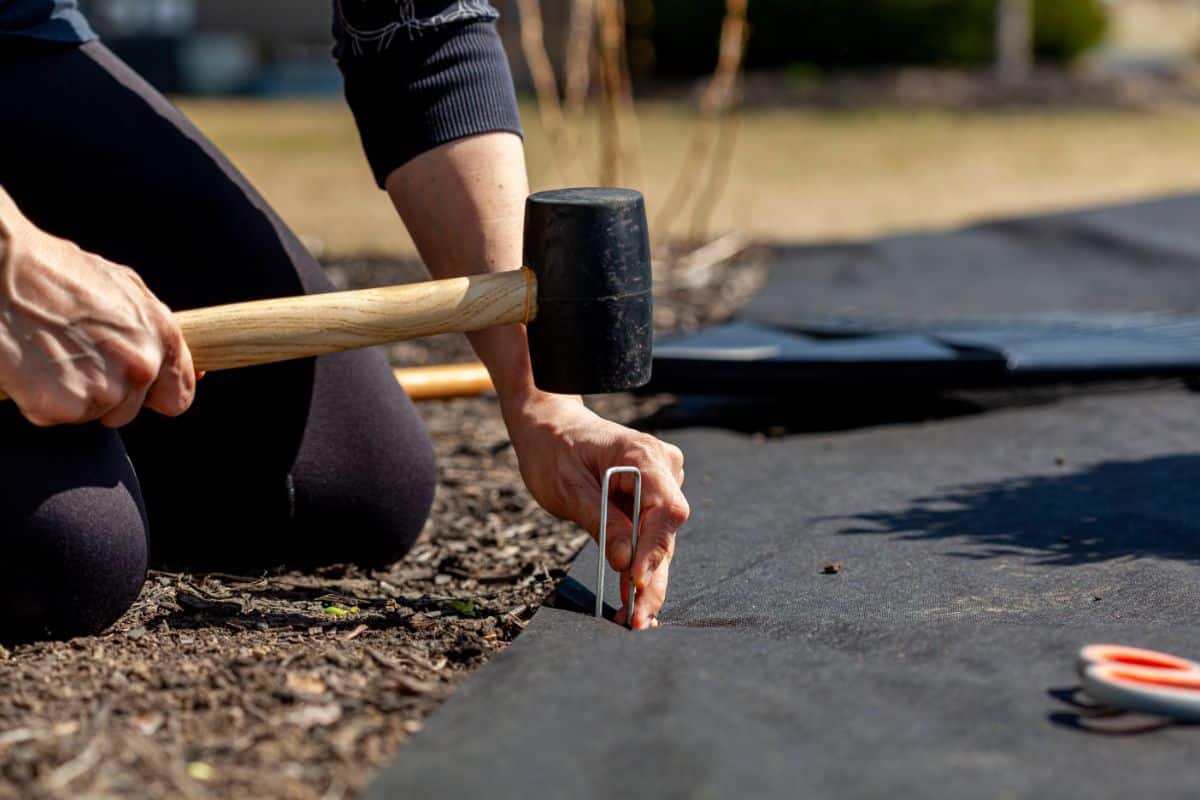
Cutting away sections of multiflora roses and digging up their roots can do a lot to remove existing plants, but multiflora roses produce tons of seeds, especially if they’ve been growing in an area for a while. Unfortunately, those seeds can last in an environment for years, and digging up the soil and clearing the land of existing multiflora rose bushes often inadvertently plants those rose seeds and causes new plants to germinate. That means that even after digging up the plants, there’s still some work to do!
One of the best ways to keep new multiflora rose plants from sprouting is to cover up the area with black plastic sheeting or plastic mulch. This plastic sheeting will prevent new seeds from sprouting, and it will smother any sections of roots and stems that you missed.
Plastic sheeting should be applied after cutting away and digging up as much of the rose plant as possible. If you cut sections of the bush down low to the ground, you may be able to apply sheeting over those sections as well to keep sunlight and water from reaching them. Over time, this will deprive the plants of the light and nutrients they need, and they will begin to die back.
To install plastic sheeting, select a product that is sturdy and thick to ensure that sprouts won’t be able to easily push their way through it. Spread the sheeting out over the entire area where you had rose bushes. It’s even better if you can extend the sheeting a few feet beyond this area just in case the shrub dropped rosehips.
Anchor the sheeting in place with landscape staples, rocks, or bricks, and then check the area regularly to make sure sprouts aren’t poking through the plastic or growing out from beneath it. If any new growth appears, nip it off with pruners. If you do this often enough, you will eventually weaken the remaining plant roots so much that they won’t regrow.
Plastic sheeting should be left in place for as long as possible to keep plants from regrowing and make sure they are smothered out completely. Ideally, sheeting should be left in place for at least a growing season or two. If you’re looking for a more eco-friendly alternative to plastic sheeting, multiple layers of thick cardboard can also keep multiflora roses from regrowing, and cardboard will eventually biodegrade too!
Planting fast-growing natives
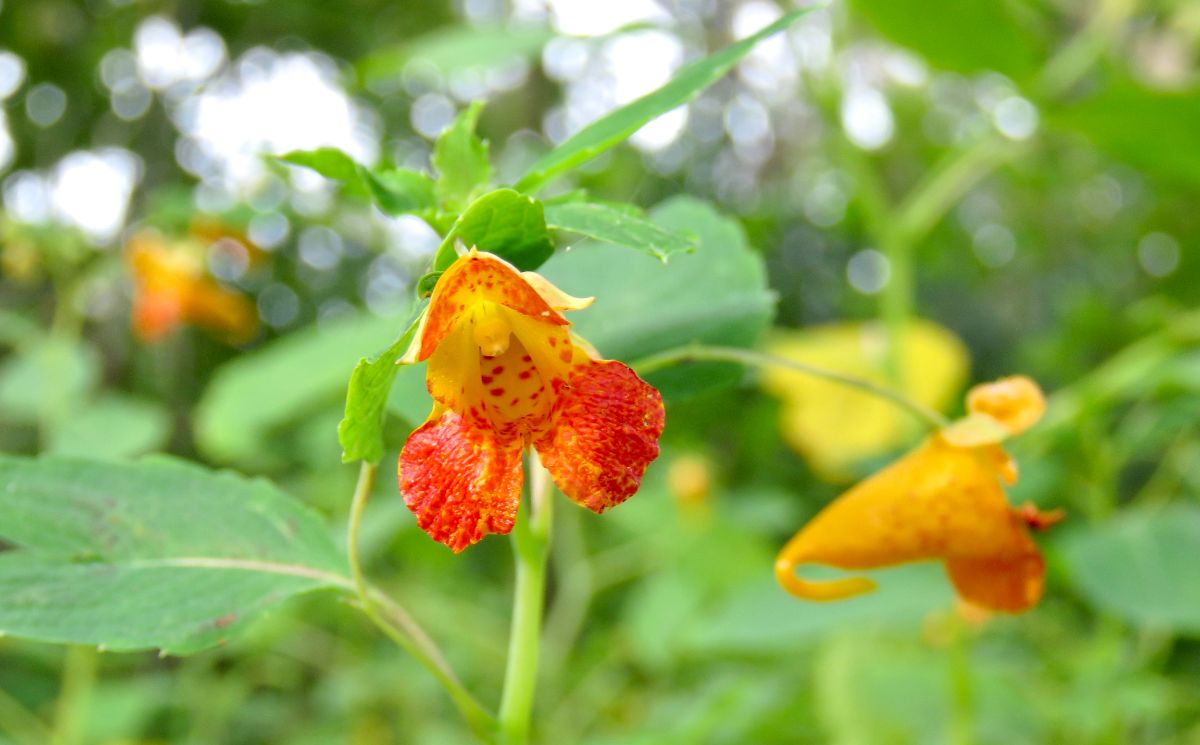
As the saying goes, “nature abhors a vacuum,” and if you remove invasive multiflora roses from an area, more multiflora roses or invasive plants may creep back in and repopulate the empty soil. That’s why it’s important to consider replanting the area after removing multiflora roses.
If you’re just starting the removal process to eradiate multiflora roses, you may not want to sow any new plants right away since you’ll need to access the area to cut down multiflora shoots several times. You also may not want to replant the area immediately if you’ve installed plastic sheeting to smother out rose seeds and new regrowth. However, if you’ve stayed on top of multiflora rose removal, there will eventually come a time when you’ll need to replant that area.
Some of the best plants to grow after removing invasives are fast-growing native plants. These rapid growers can quickly repopulate barren earth, ensuring that other invasive plants won’t be able to creep back in. Plus, sowing native plants will help to reestablish the biodiversity and ecological landscape that was destroyed by the multiflora roses.
While the right native plants for your garden will depend on your growing location and climate, the list below includes a variety of fast-growing native plants that can help to repopulate your garden:
- Viburnums
- Asters
- Blue iris
- Goldenrod
- Wild ginger
- Flowering raspberry
- Jewelweed (Impatiens capensis)
- Joe Pye weed
- Swamp milkweed
- Mountain mint
- Solomon’s seal
Using livestock

While cutting and digging multiflora roses can be an effective way to remove them, if you have the space for it, you may want to enlist livestock to do the work for you.
Today, there are companies that will rent goats and other livestock for weed and invasive plant removal. Goats, in particular, can tackle multiflora roses, and they happen to leave behind a nutrient-rich compost as they do their work too!
While renting goats may not be for everyone, goats can mow down large areas of multiflora roses, and they can chew through plants that are up to 5’ tall! When you hire goats, the company will come to your property to install temporary fencing around the plants you’d like to remove and then release the goats into the space. After the goats have done their work, the company will return to retrieve their ruminants, and you’ll be left with a garden space that has much fewer weeds and invasive plants.
Mitigating spread
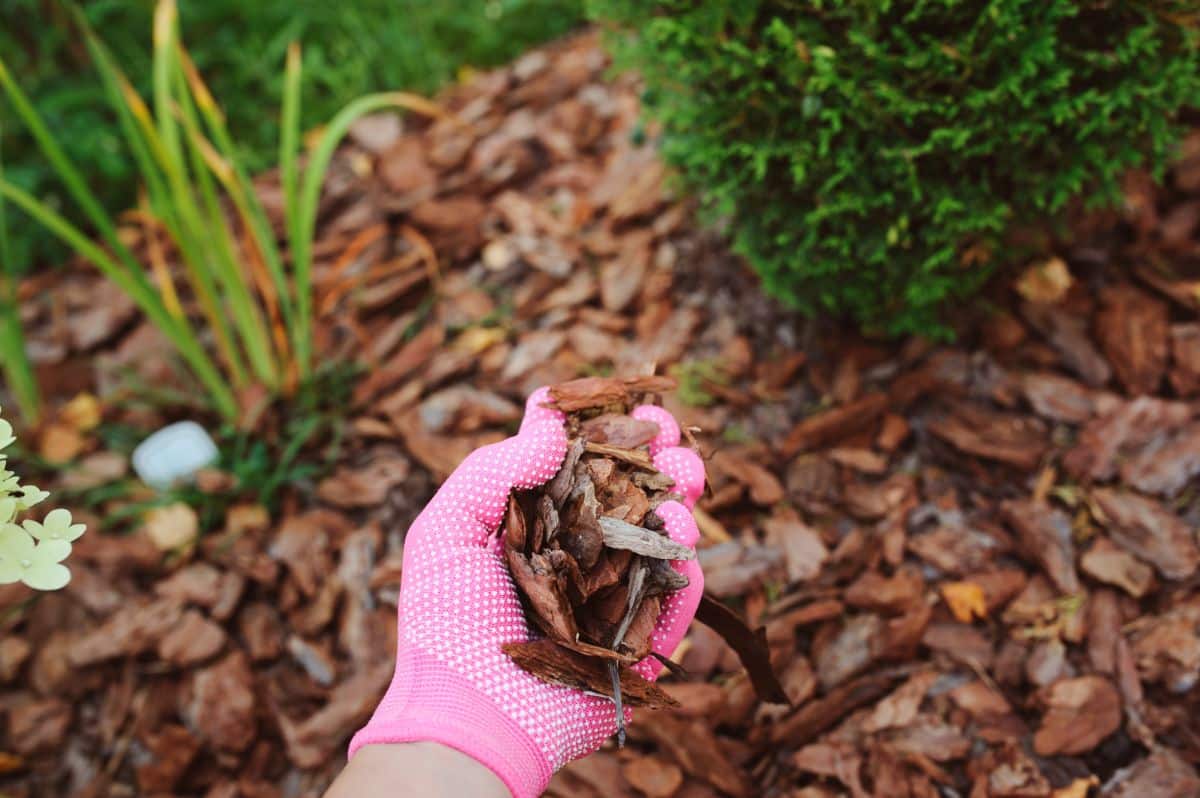
When it comes to invasive plants like multiflora rose, removing plants as quickly as possible can keep them from spreading. But once you’ve pulled out these shrubs from your property, there are certain steps you can take to make sure they don’t become a problem again.
First, if there is a spot in your garden that once housed multiflora roses, check that area often to make sure nothing regrows. After that, consider adding mulch around your beds, which is a great way to prevent weeds and invasive plants from taking root. Wood mulch, salt marsh hay, pine needles, and other natural mulches are all ideal for suppressing weeds and preventing invasives.
Beyond this, be careful not to accidentally track invasive plants into your garden. If you were in an area with invasive plants, check your shoes over carefully and maybe even give them a good rinse to make sure they aren’t carrying any seeds that may sprout elsewhere. Also, never take cuttings or rosehips from rose bushes you can’t identify because you could inadvertently spread multiflora roses around!
Safe disposal of invasive plant material
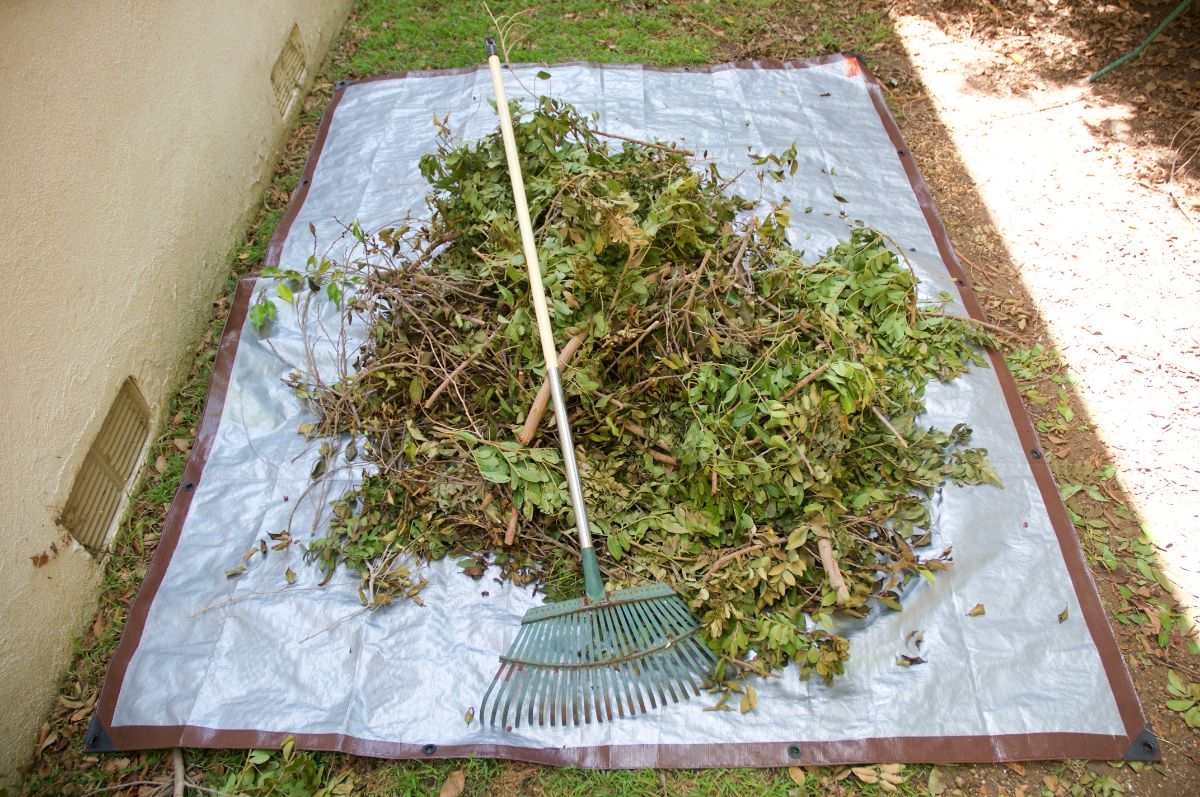
Remember how you gathered all of the multiflora rose stems, leaves, and roots on a tarp while cutting back and digging out the plants? Well, don’t throw that plant debris in the trash or compost heap, as you could accidentally sow more invasive plants!
When dealing with invasive plants, it’s essential that you dispose of all plant parts in a safe way. One option is to contact your local waste management company and ask about their regulations on invasive plant disposal. Some companies will accept invasive plant material, but others won’t, so it’s important to ask!
Another option is to make a fire and burn any branches and stems that you removed from multiflora rose shrubs. Not all invasive plants should be burned (for example, poison ivy can cause breathing issues if you burn it), but multiflora roses can be disposed of in outdoor fires as long as you follow proper fire safety procedures.
You can also spread out all plant debris on a tarp or bag it up in construction-grade trash bags. Then place the tarp or trash bags on your driveway on a hot day and allow the plant matter to bake in the sun. Once the stems, roots, and leaves are fully dry and crispy, they can be tossed in the trash; however, they shouldn’t be composted as they may contain seeds.
Frequently asked questions
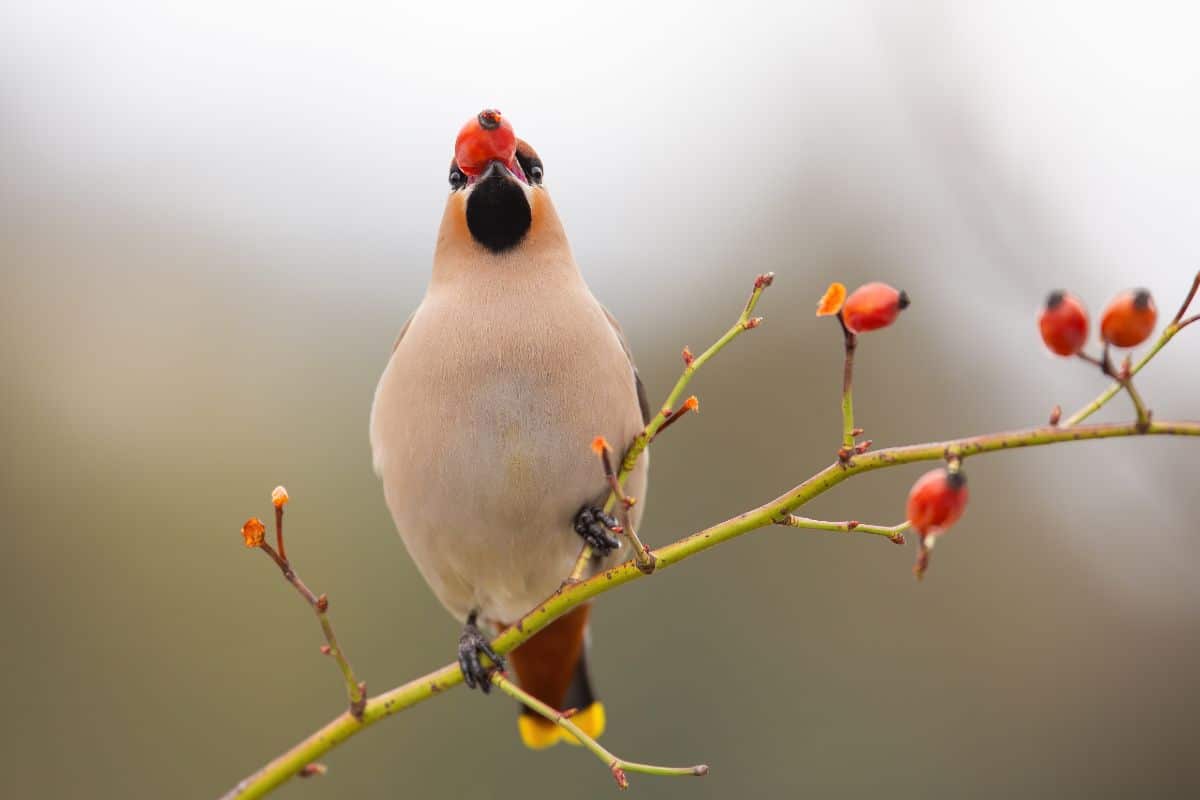
Mowing often and cutting back multiflora roses at least 3 to 6 times per growing season will keep them from spreading and eventually weaken the plants. You can also prevent the spread of multiflora roses by not transplanting rosehips from one location to another. And it’s always wise to check the treads of your shoes for invasive plant seeds to avoid inadvertently transporting them to your garden.
Like other invasive plants, multiflora roses will outcompete many native plants, reducing biodiversity and changing habitats. Multiflora roses also have thorny stems that can reduce the ability of animals and people to move throughout landscapes.
Like other roses, multiflora roses have edible rosehips that are high in vitamin C and can be used in herbal teas, desserts, and jams. Eating invasive plants is a great way to put them to use and prevent them from spreading as well. Just be careful when harvesting rosehips because you don’t want to accidentally spread their seeds around!
Multiflora roses were initially used as ornamental plants and privacy screens. Their thorny stems also made them ideal for fencing livestock, and their strong root system caused them to be grown for erosion control too. But while multiflora roses can be attractive, they are destructive, invasive plants that pose risks to habitats and wildlife, and they generally should be removed whenever possible.
Yes, deer will eat multiflora roses! So, if you see deer browsing in your rosebush, that’s not necessarily a bad thing!
Yes, wild birds will eat multiflora rosehips, particularly in winter. This causes problems because wild birds can readily spread the seeds from multiflora roses after feeding. That’s why it’s a good idea to always keep your garden well mulched, so it’s less likely that seeds can find purchase!
Summary
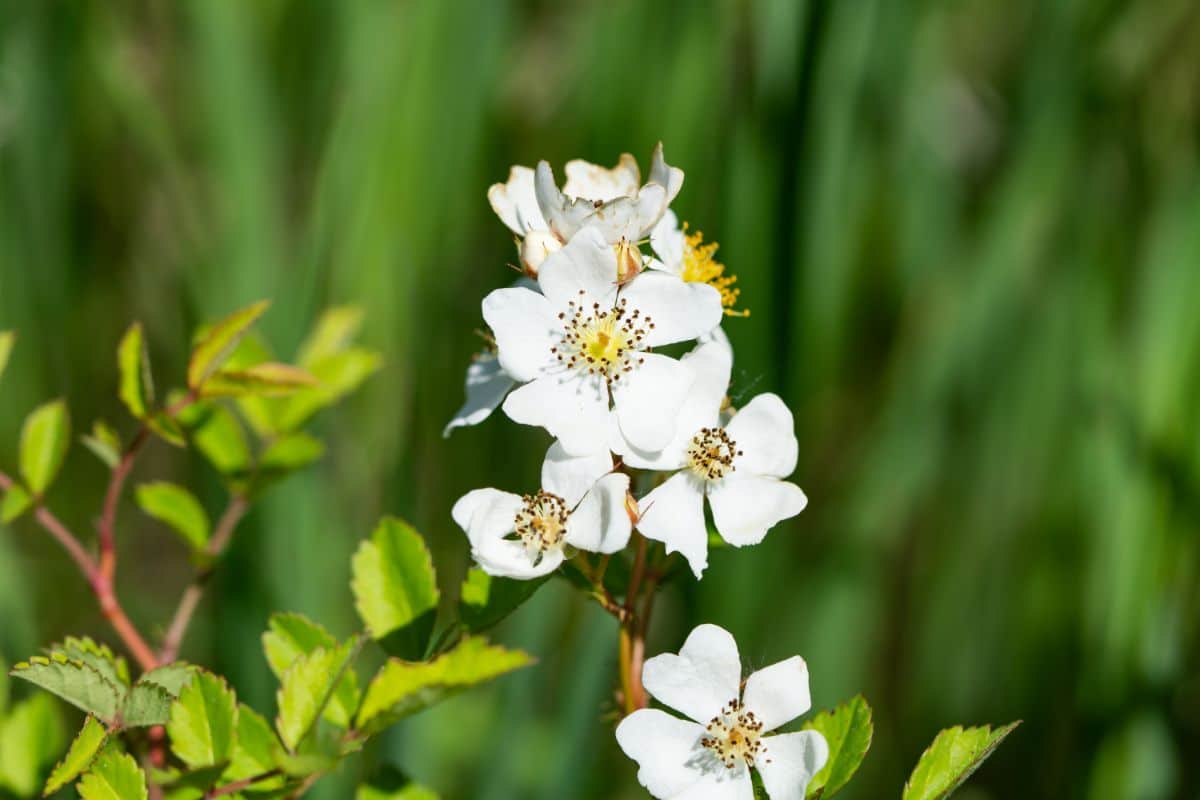
While multiflora roses may look pretty in the garden, they can cause problems for the local environment and wildlife, and it's best to never grow them intentionally. However, if you already have multiflora roses growing in your yard, there are ways to tackle them without ever resorting to chemicals.
Although manually removing invasive plants can be more time-consuming, the tradeoff is that you’re working with nature, and you aren’t adding any unnecessary chemicals to the soil or the groundwater. And, as long as you are consistent, you can effectively eradicate multiflora roses and other invasives, too, with a bit of elbow grease and know-how!
Once you remove invasive plants from your garden, you will want to think about what to plant next. Sowing these native plants can help to create a more biodiverse landscape and lure native pollinators and wildlife back to your garden.

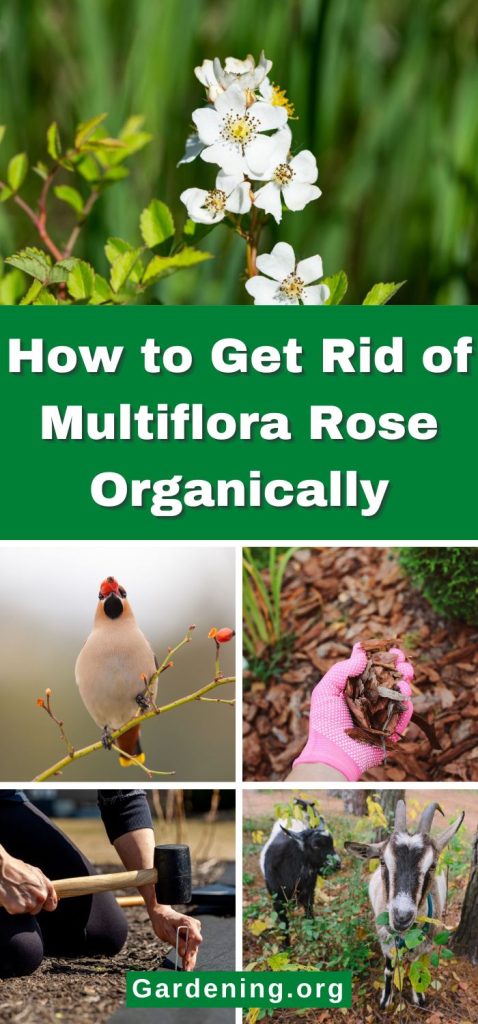
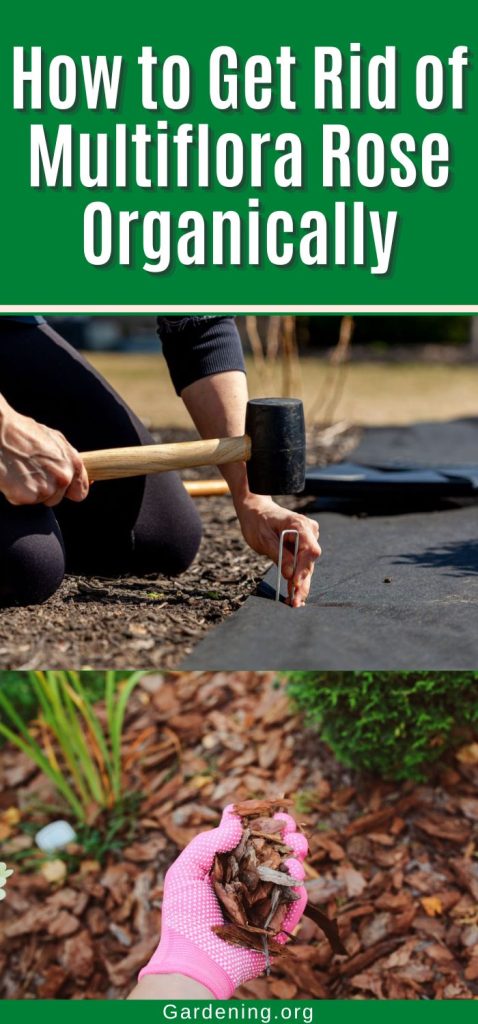
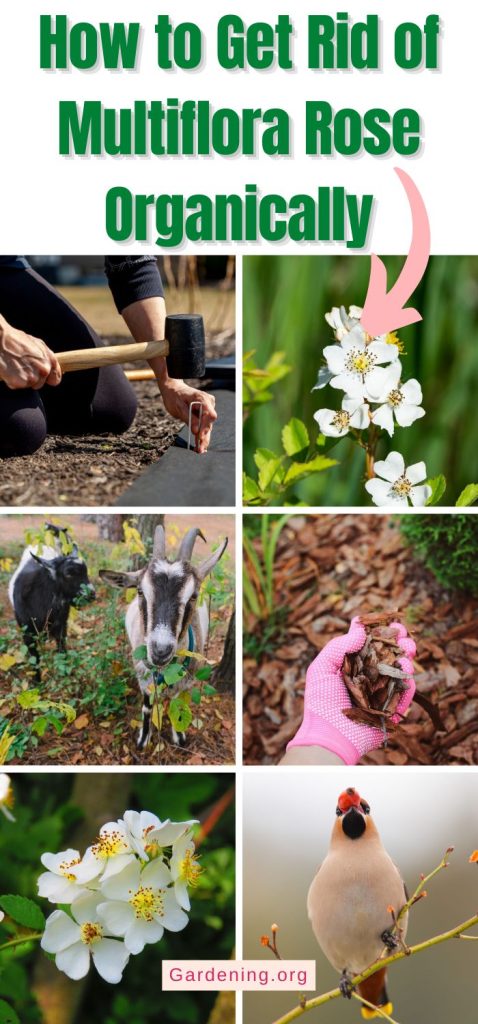
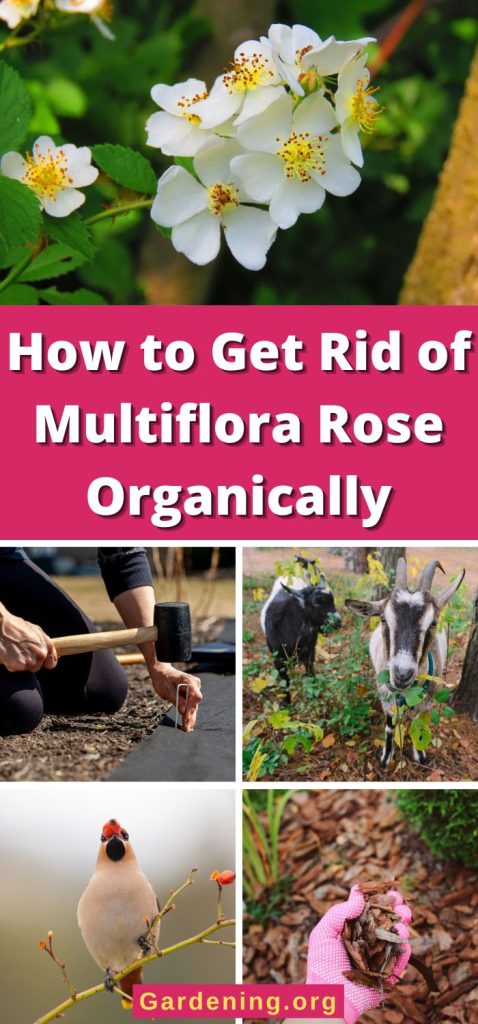




Leave a Reply